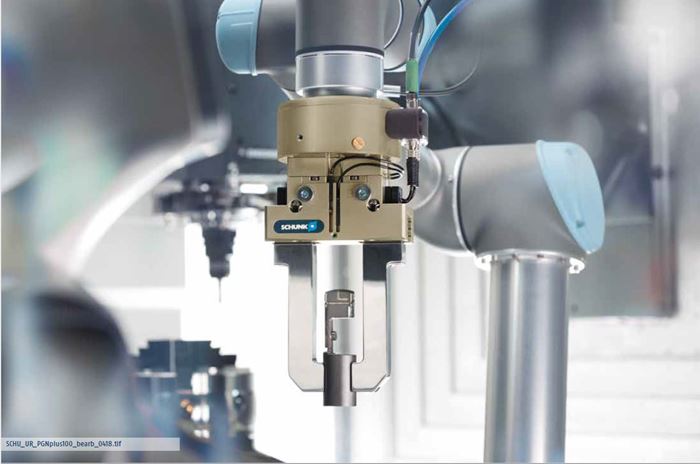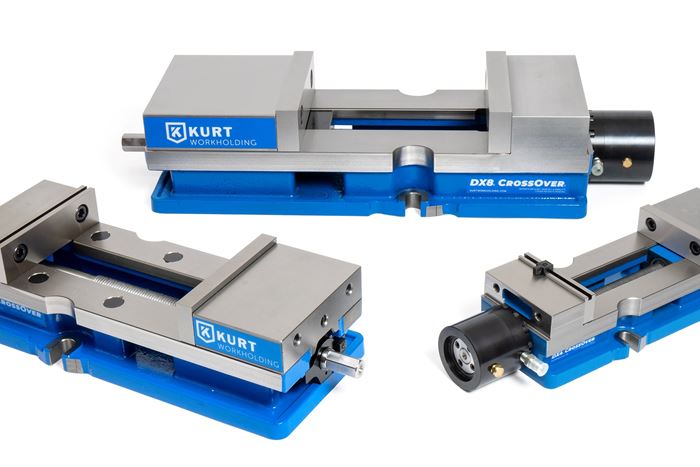Workholding refers to any device that is used to a secure a workpiece against the forces of machining. The most basic workholding device is a simple clamp, but workholding can also involve complex fixtures that are custom-built for particular parts. Other common workholding devices include vises and chucks, as well as indexers or rotary tables that are able to change the part’s position while it is held, so the machine can reach various features. In most machining applications, workholding also locates the part. On a machining center, for example, a vise or fixture may also provide the precise position and orientation where the machining program expects to find the workpiece.
Lean Approach to Automated Machine Tending Delivers Quicker Paths to Success
Almost any shop can automate at least some of its production, even in low-volume, high-mix applications. The key to getting started is finding the simplest solutions that fit your requirements. It helps to work with an automation partner that understands your needs.
Workholding: Essential Reading
A Case for Combining Workholding with Optical Scanning
Automotive dies and die inserts are often complex, one-off parts with little room for error. Integrity Tool's investments in modular workholding tools and 3D optical scanning have allowed the company to create niche capabilities for its CNC machined parts.
When To Use A Collet Chuck
Don't assume the standard chuck is the right workholding for every lathe application.
Workholding 101
No universal workholding solution exists, so machine shop employees should have a basic understanding of multiple ways they can secure workpieces.
3 Uses for a Composite Polymer 3D Printer in a CNC Machine Shop
When RPG purchased its metal 3D printer, a polymer printer was part of the deal. Three uses this job shop has found for this fused filament fabrication system.
Vacuum Workholding for Thin Parts: First Episode of The One-Person Shop
A new video series looks at technology and practices for thriving as a very small machining business. In this episode, how workholding using air pressure permits rapid setup of parts too delicate to be held in a vise.

FAQ: Workholding
What is workholding?
Workholding refers to any device that is used to a secure a workpiece against the forces of machining. The most basic workholding device is a simple clamp, but workholding can also involve complex fixtures that are custom-built for particular parts. Other common workholding devices include vises and chucks, as well as indexers or rotary tables that are able to change the part’s position while it is held, so the machine can reach various features.
When should you use flexible workholding?
For shops that handle short-run and one-off jobs, flexible workholding is key to producing work cost-effectively. This might involve quick-change workholding that speeds setups, or solutions that leave the sides of parts free for machining, requiring fewer setups.
When should you use automation-ready workholding?
As more shops add automation, they will need workholding systems that are compatible with the systems they’ve implemented, whether they’re robots, pallet systems or something else.
When should you use ID Workholding?
ID workholding, such as expanding mandrels, has a number of benefits and is suited to a range of applications. These fixtures can provide full access to a part’s OD, providing a rigid, even hold that increases accuracy.
What are some tips to consider when using five-axis workholding?
1. Size the Five-Axis Machine Correctly
2. Consider Augmenting Dovetails
3. Get Out of Your Comfort Zone
What is a collet chuck?
The collet chuck is an alternate workholding device that, like the jaw chuck, also uses mechanical force to hold the part being turned. While a collet chuck lacks the capacity for the same wide range of workpiece sizes that a jaw chuck can accommodate, it offers advantages related to speed, accuracy and productivity that may be crucial for certain jobs.
Source: When To Use A Collet Chuck

Workholding Suppliers
Narrow by Workholding Category
- Actuators, Hydraulic & Pneumatic
- All Other Workpiece Handling, Loading & Feeding Equipment not specified
- Angle & Sub Plates
- Arbors, Expandable Workholding
- Centers, Live & Other
- Chuck Jaws & Collets
- Chucks, Collet Type (for Workholding)
- Chucks, Diaphragm
- Chucks, Gear
- Chucks, Index
- Chucks, Jaw Type
- Chucks, Magnetic
- Chucks, Power
- Chucks, Precision
- Chucks, Self-Contained
- Chucks, Special
- Chucks, Vacuum
- Clamps & Fixturing Devices
- Collets for Workholding
- Dividing & Indexing Heads
- Fixturing Systems
- Guide Bushings (for Swiss Lathes)
- Indexers & Rotary Tables
- Mandrels
- Pedestal Type Fixtures & Tombstone Blocks
- Steady Rests
- Vises & Vise Jaws
- Workholding, Custom
Fixturing Castings Made Simple Through Adhesive Workholding
When a casting proved too malleable for traditional gripping, Thomas/Euclid Industries adopted — and succeeded with — Blue Photon adhesive workholding.
Palmgren Vise Eliminates Jaw Wobble
The bench-and-pipe vise’s spindle and nut are housed in a square tube casting for protection from dust, chips and moisture.
Jergens Vise Features Hardened Jaw Plates to Combat Lifting
The 5" heavy duty machine vise is designed to be easily moved and relocated, speeding up the time in between change overs and reducing operator fatigue.
Dillon Jaw Forming Rings Provide Improved Part Concentricity
The jaw forming rings provide uniform pressure for a more consistent bore on large-diameter chucks.
Jergens Pallet System Provides Fast Changeovers
The Quick-Loc 2 pallet range is compatible with existing top tooling, reportedly providing repeatability of 0.0003″ and clamping forces of nearly 14,000 lbs.
Custom Workholding Principles to Live By
Workholding solutions can take on infinite forms and all would be correct to some degree. Follow these tips to help optimize custom workholding solutions.
#Basics
Dillon Hard Jaws Reduce Part Slippage
The hard jaws feature aggressive, diamond-shaped serrations and are designed for cast parts, scaly parts or parts with imperfections.





















